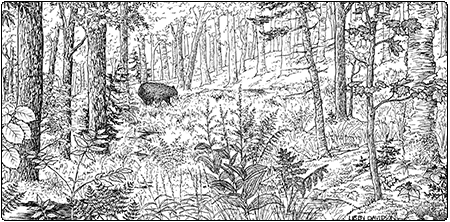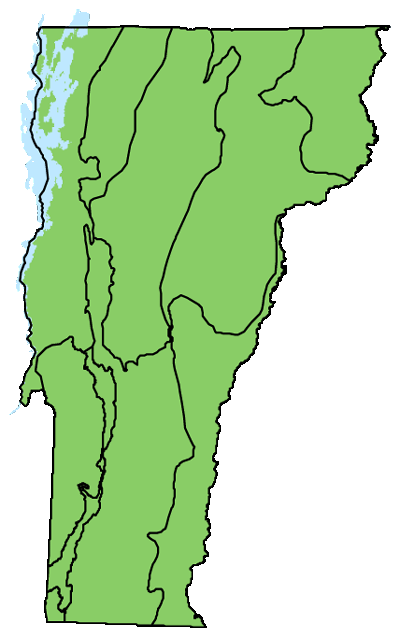Ecology and Physical Setting
Often sprawling across expanses of gently sloping land, these wet forests are a meeting place for upland and wetland species. There are few other communities where species like black ash and sugar maple grow side by side. Northern Hardwood Seepage Forests occur where shallow bedrock or hardpan results in horizontal flow, and sometimes surface discharge, of groundwater. The rate of groundwater movement, seasonal duration of soil saturation, and chemical composition of the water all shape these forests. The source of seepage is variable. In some cases, seepage may be emerging where dense basal till forces an upwelling of water that has traveled through the more porous ablation till upslope (Phillips 2017). This often occurs where steep slopes transition to more gentle slopes, a landscape position where seepage forests are often found. Snowmelt may provide an early-season influx of water to supplement the groundwater.
The soils are loams or silt loams, rich in organic material and frequently stony or gravelly. In many cases, shallow surface layers of muck occur atop dense till, which prevents the water from infiltrating. Deep organic soils do not accumulate because of fluctuating water tables. The ground surface tends to be uneven, creating a fine-scale mosaic of upland and wetland conditions with elevation changes of several inches to two feet. This microtopography is the result of both mineral soil unevenness, and hummocks and hollows created by shallow-rooted tree tip-ups. Boulders also create microtopography in some settings. Small open seeps and seepage runs are common, and these often coalesce to form stream channels.
Northern Hardwood Seepage Forests frequently form the headwaters of small streams, and the relatively constant flow of cold groundwater plays an important role in downstream water quality. Many fish and other aquatic organisms depend on well-oxygenated cold water. During hot summer months, these cold-water inputs to streams and rivers can be critical to the survival of these organisms. In addition, Northern Hardwood Seepage Forests absorb and slow runoff from heavy rainstorms, helping moderate the potential for extreme flooding downstream.
These forests are almost always a mix of wetland and upland, with wetland predominating. The proportion of wetland is often 70 percent or more. In both wetland and upland areas, soil saturation, shallow-rooted trees, tree tip-ups, and water movement are the primary ecological processes.
Vegetation
The canopy varies from somewhat open to closed. The wetter sites have sparse tree cover. In these places, trees are shallow-rooted, of small stature and diameter, and will topple if they grow large and become exposed to strong winds. The relatively drier sites have a more closed canopy and support vigorous tree growth. Trees typically include yellow birch, sugar maple, black ash, red maple, and white ash. Softwood species, including eastern hemlock, red spruce, and balsam fir, can also be important in the canopy, and are sometimes even dominant. Shrub cover is sparse, though hobblebush is often present.
Herbs are diverse and are strongly influenced by the underlying soil saturation and mineral enrichment from the groundwater. Vegetation varies greatly from hummock to hollow. Wetland hollows support species such as water avens, golden saxifrage, false hellebore, wood nettle, nodding sedge, foamflower, sensitive fern, and cinnamon fern. Upland hummocks support herbs such as intermediate wood fern, lady fern, sarsaparilla, and bunchberry. Particularly enriched Northern Hardwood Seepage Forests can support blue cohosh, plantain-leaved sedge, and other rich woods species.
Wildlife Habitat
Because groundwater moderates the soil temperature, seepage forests are among the first places to green up in spring. The fresh growth feeds many animals, including black bears and wild turkeys. Seepage forests with more softwood cover likely provide favorable foraging habitat and protective cover for white-tailed deer. Northern two-lined salamanders, northern dusky salamanders, and spring salamanders all find summer refuge in the steady supply of cool running water of seeps and small streams, where they also lay their eggs. Winter wrens, easily identified by their long musical song, nest in the abundant root tip-ups. With the characteristic bobbing of their bodies and wagging of their tails, northern waterthrushes may be observed foraging on the edges of pools and water tracks. Other breeding birds include veery, Canada warbler, and red-shouldered hawk.
Variants
- Montane Seepage Forest is found on mountain slopes above 2,000 feet. Yellow birch, red spruce, and/or balsam fir form the canopy, and characteristic herb species include false hellebore, inflated sedge, mountain wood fern, and boreal bedstraw. These forests often have large, well-spaced canopy trees resulting in a distinct glade structure.
- Hemlock Seepage Forest has a canopy with more than 75 percent hemlock. Understory herbs may be sparse in acidic, densely shaded forests, or abundant and diverse in open canopy forests with calcium-rich groundwater seepage.
- Black Ash Seepage Woodland is a very wet forest with an open canopy (less than 60% cover) of black ash, and less pronounced hummocks and hollows. The ground is blanketed with dense carpets of slender mannagrass, jewelweed, purple-stemmed aster, and sensitive fern. Dwarf raspberry, golden saxifrage, and water avens colonize the wettest hollows.
Related Communities
- Woodland Seep is usually a small (less than one half acre), discrete area characterized by groundwater discharge and an absence of trees. Woodland Seeps are almost always found as inclusions within upland forest types.
- Northern White Cedar Seepage Forest has greater than 75 percent cover of northern white cedar, and the ground surface has many areas of needle and twig-covered soil.
- Northern Hardwood Forest can share many species with the upland portions of Northern Hardwood Seepage Forest, but it is an entirely upland community and is not influenced by wetland processes.
- Rich Northern Hardwood Forest can share some species with the low, wet portions of Northern Hardwood Seepage Forest, but it lacks the soils, plants, and ecological processes of wetlands.
Conservation Status and Management Considerations
Northern Hardwood Seepage Forest is an uncommon natural community in Vermont. Most known examples are on conserved lands, but it is likely that many more high-quality examples exist throughout the state. Additional inventory and conservation efforts are needed to ensure that the range of variation expressed in this community is understood and protected.
The hybrid wetland-upland character of this community poses notable challenges for forest management. While these forests can produce merchantable timber, they may be difficult to access without damaging the wetland soils. Soil compaction and rutting alter groundwater and surface water flows and can permanently impact seepage forests and their downstream water quality functions. Care should be taken to retain the hummock-hollow topography and natural hydrology. Large patch cuts should be avoided, as removal of the canopy can significantly reduce evapotranspiration, altering the hydrologic regime. In extreme cases, canopy removal can convert seepage forests to even wetter shrub or sedge-dominated wetlands.
Distribution/Abundance
Northern Hardwood Seepage Forests are likely found throughout Vermont, though this community is still poorly documented in the southern portion of the state. Most of the known examples in Vermont occur in the Northern Green Mountains, Northern Vermont Piedmont, and Northeastern Highlands. Similar communities occur in Maine and New Hampshire.
Characteristic Plants
Trees
Abundant Species
Sugar maple – Acer saccharum
Yellow birch – Betula alleghaniensis
Black ash – Fraxinus nigra
Occasional to Locally Abundant Species
Red maple – Acer rubrum
White ash – Fraxinus americana
American elm – Ulmus americana
Eastern hemlock – Tsuga canadensis
Red spruce – Picea rubens
Balsam fir – Abies balsamea
Shrubs
Occasional to Locally Abundant Species
Hobblebush – Viburnum lantanoides
Striped maple – Acer pensylvanicum
Mountain maple – Acer spicatum
Beaked hazelnut – Corylus cornuta
Alder-leaved buckthorn – Rhamnus alnifolia
Dwarf raspberry – Rubus pubescens
Herbs – Hollows
Abundant Species
False hellebore – Veratrum viride
Lady fern – Athyrium filix-femina
Foamflower – Tiarella cordifolia
Nodding sedge – Carex gynandra
Occasional to Locally Abundant Species
Slender mannagrass – Glyceria melicaria
Golden saxifrage – Chrysosplenium americanum
Water avens – Geum rivale
Cinnamon fern – Osmundastrum cinnamomeum
Rough-stemmed sedge – Carex scabrata
Wood nettle – Laportea canadensis
Sensitive fern – Onoclea sensibilis
Purple-stemmed aster – Symphyotrichum puniceum
Jewelweeds – Impatiens spp.
Bog-candles – Platanthera dilatata
Large purple fringed orchid – Platanthera grandiflora
Herbs – Hummocks
Abundant Species
Intermediate wood fern – Dryopteris intermedia
Sarsaparilla – Aralia nudicaulis
Bunchberry – Cornus canadensis
Occasional to Locally Abundant Species
Whorled aster – Oclemena acuminata
Canada mayflower – Maianthemum canadense
False Solomon’s seal – Maianthemum racemosum
Starflower – Lysimachia borealis
Zigzag goldenrod – Solidago flexicaulis
Common wood sorrel – Oxalis montana
Lady fern – Athyrium filix-femina
Blue cohosh – Caulophyllum thalictroides
Rare and Uncommon Plants
Boreal bedstraw – Galium kamtschaticum
Musk flower – Erythranthe moschata
Associated Animals
Northern two-lined salamander – Eurycea bislineata
Northern dusky salamander – Desmognathus fuscus
Spring salamander – Gyrinophilus porphyriticus
Mink – Neovison vison
American beaver – Castor canadensis
Masked shrew – Sorex cinereus
Black bear – Ursus americanus
Winter wren – Troglodytes hiemalis
Northern waterthrush – Parkesia noveboracensis
Canada warbler – Cardellina canadensis
Veery – Catharus fuscescens
Eastern red damsel – Amphiagrion saucium
Rare and Uncommon Animals
Red-shouldered hawk – Buteo lineatus
Places to Visit
Averill Mountain Wildlife Management Area, Norton, Vermont Fish and Wildlife Department (VFWD)
Steam Mill Brook Wildlife Management Area, Walden, VFWD
Green River Reservoir State Park, Hyde Park, Vermont Department of Forests, Parks, and Recreation.
Stranahan Town Forest, Marshfield, Town of Marshfield
